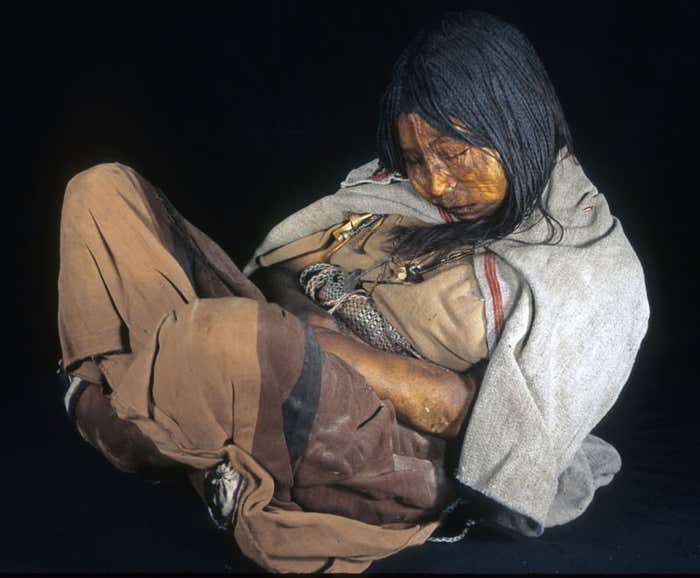La Doncella, also known as the Frozen Maiden, is a mummified Inca girl discovered in the Andes of Argentina. Her remarkably preserved remains, along with those of two other children (known as the Children of Llullaillaco), provide invaluable insights into ancient Inca culture, rituals, and beliefs. La Doncella’s story is a captivating blend of archaeological discovery, scientific analysis, and cultural significance, shedding light on the mysteries of the past and the enduring legacy of indigenous peoples in the Americas.
The discovery of La Doncella occurred in 1999 on Mount Llullaillaco, a dormant volcano located in the northwestern province of Salta, Argentina. The mummified remains of La Doncella, along with those of two other children, were found at an altitude of over 22,000 feet (6,700 meters), making them among the highest-altitude mummies ever discovered.
La Doncella is believed to have been around 15 years old at the time of her death, based on dental and skeletal analyses. Her body, clothing, and belongings were remarkably well-preserved, thanks to the extreme cold and dry conditions of the high-altitude environment. This preservation allowed archaeologists and scientists to study her remains in unprecedented detail, unraveling aspects of her life, health, and the circumstances of her death.
The study of La Doncella’s remains revealed valuable information about her origins, lifestyle, and social status within the Inca society. Isotopic analysis of her hair and teeth provided insights into her diet, geographic origin, and exposure to environmental factors. It is believed that she was raised in the Cusco region of Peru, the heartland of the Inca Empire, and that her diet primarily consisted of maize, potatoes, and other Andean crops.
La Doncella’s clothing and adornments were indicative of her status as an elite individual, possibly belonging to a noble or priestly family. She wore intricately woven textiles, including a fine tunic and a feathered headdress, adorned with colorful beads and ornaments made of gold and silver. These luxurious garments and accessories reflected the wealth and social prestige of the Inca elite, highlighting the importance of material culture in conveying status and identity.
One of the most intriguing aspects of La Doncella’s story is the manner of her death and the role she may have played in Inca religious ceremonies. Evidence suggests that she was subjected to a sacrificial ritual known as capacocha, in which selected individuals were offered to the gods as part of important religious events or cosmic events. Capacocha sacrifices were seen as acts of great honor and privilege, as those chosen were believed to transcend into a state of spiritual purity and become intermediaries between the earthly realm and the divine.
The circumstances surrounding La Doncella’s sacrifice remain a subject of speculation and debate among scholars. Some theories propose that she was a willing participant in the ritual, chosen for her purity and devotion to the gods. Others suggest that capacocha sacrifices may have been coerced or compelled, involving individuals who were deemed expendable or politically significant.
Regardless of the specifics of her sacrifice, La Doncella’s mummified remains offer poignant insights into the religious beliefs and practices of the Inca Empire. Her well-preserved state, along with the meticulous care taken in preparing her for the afterlife, underscores the importance of death rituals and ancestor veneration in Inca society.
In addition to her role in capacocha rituals, La Doncella’s story raises questions about the broader significance of human sacrifice in pre-Columbian cultures. The Inca, like many ancient civilizations, believed in the necessity of offerings to appease the gods, ensure fertility and prosperity, and maintain cosmic balance. Human sacrifices, while shocking from a modern perspective, were viewed as essential for maintaining harmony between the human, natural, and supernatural worlds.
The discovery of La Doncella and the Children of Llullaillaco has prompted discussions about the ethics of archaeological research, particularly concerning the study and display of human remains associated with sacrificial practices. Museums and institutions housing these mummies have worked closely with indigenous communities and representatives to address concerns about cultural sensitivity, respect for the deceased, and the interpretation of their cultural heritage.
The legacy of La Doncella and the Children of Llullaillaco extends beyond their archaeological significance, serving as powerful symbols of the resilience and enduring cultural traditions of indigenous peoples in the Americas. Their stories remind us of the complex interplay between religion, society, and identity in ancient civilizations, and the ongoing efforts to preserve and honor indigenous heritage in the modern world.
